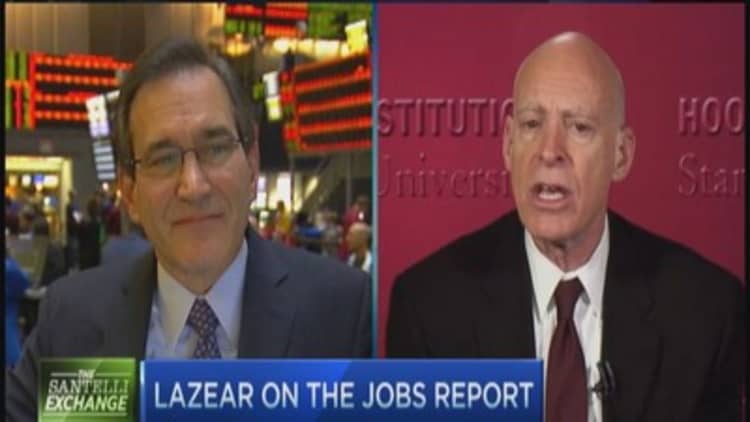November's surprisingly strong job growth and wage gains sparked talk of an earlier Fed rate hike, but that's not likely without several months of solid improvement, strategists say.
Nonfarm payrolls increased by a stunning 321,000 in November, the best jobs gain since January 2012, and average hourly earnings rose by 9 cents, for a 2.1 percent year-over-year rise. Stock futures sold off on the headlines and bond yields shot higher, on speculation the Fed would come off the sidelines with an earlier rate hike.
Read MoreStrong jobs report gives Fed green light
Fed fund futures immediately moved up the first rate rise to June from September. Market expectations had been trailing Fed forecasts, including a comment earlier this week from New York Fed President William Dudley that he expected the first rate hike midyear.
"The market has effectively accelerated its expectation for a Fed rate hike by a full quarter simply on the basis of this jobs number," said Adrian Miller, director of fixed income strategy at GMP Securities. "By September, it is expecting two rate hikes."

The Fed has been on the lookout for wage gains, since that would be the kindling for future inflation, but it wants to see a level closer to 3 percent and consistent advances for several months before it raises rates, strategists say. Many economists had expected the rate hike would be in the third quarter, but forecasts range from March to December.
"The payrolls is so eye-popping, that's what's going to get attention," said Ward McCarthy, chief financial economist at Jefferies. "Frankly, there are things in there that if they were going to continue it would cause the Fed to start pulling forward the potential time frame."
Read MoreThese sectors are adding lots of big exec jobs
McCarthy said the Fed is getting closer to fulfilling its employment mandate but inflation is still lacking, running below the central bank's 2 percent target.
Wages rose 0.4 percent over last month, a rate seen only two other times since the recession, and the best pace since November 2008 when the gain was 0.5 percent.
"Average hourly earnings, up 2.1 percent. That's telling us the labor market continues to improve, but the underlying labor conditions could use a whole lot more improvement before you see average hourly wage growth that would set off inflation. They should be delighted with the number," said McCarthy.
September and October nonfarm payrolls were also revised higher by more than 30,000 jobs. The report spurred a sharp move higher in Treasury yields, with the 2-year up 8 basis points to 0.63 percent.
Read MoreLookto the sky for this job opportunity
"It confirms the midyear rate hike rather than bringing forward expectations in any material way," said Ian Lyngen, senior Treasury strategist at CRT Capital.
Mesirow Financial's chief financial economist, Diane Swonk, agrees the Fed rate hike will not be brought forward by one report alone, but her expectations are for a third-quarter rate rise. "Their greatest fear is 1937," when the economy double dipped, she said. "They want to achieve liftoff but they don't want to reverse course. They want to achieve liftoff with a slow glide path," she said.
But there are those who believe the Fed will be forced to move sooner, and the strength of this report shows it is behind the curve.
Read More Big beat on jobs report, here's how stocks react
"Net net, the economy struck gold this morning. With one month left to go, the economy in 2014 is fast enough for companies to hire 2.65 million people. It hasn't been this fast since 1999. What is the Fed doing leaving interest rates at zero still?" wrote Chris Rupkey, chief financial economist at Bank of Tokyo-Mitsubishi.
"Our call is for a rate hike in March 2015, but our recommendation is for them to raise rates in December. The economy is better than they think. And by raising rates, the Fed tells the country and the world too, that the economy has fully recovered. A rate hike will boost the nation's confidence that the economy is heading in the right direction and the outlook is a solid one," Rupkey noted.
Rick Rieder, chief investment officer of fundamental fixed income at BlackRock, said he sees the first rate hike in June. "The report likely moves forward the Fed's timetable for its initial policy rate hike and suggests that June should be the latest point we see an initial hike, and preferably sooner, but the Fed will probably hold off until then," he wrote.
Rieder said in a note that the stage is now set for a policy environment that diverges from the economic environment. That means a positive performance in risk assets and higher interest rates, led by the front end of the curve.


